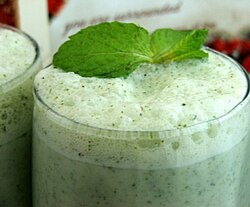Chaas
 A glass full of chaas | |
| Course | Beverage |
|---|---|
| Place of origin | Indian subcontinent |
| Region or state | Indian subcontinent |
| Associated national cuisine | India |
| Main ingredients | Dahi (yogurt), water, spices |
Chaas (gu:છાશ chhash, hi:छाछ chhachh) is a dahi (yogurt)-based drink popular across the Indian subcontinent.[1] It is also written chhaachh. In the Rajasthan region of the Indian subcontinent, it is called ghol. It is called moru മോര് in Tamil and Malayalam, taak ताक in Marathi, majjiga in Telugu, majjige in Kannada, ale (pronounced a-lay) in Tulu. It is often called laban in the Old Dhaka in Bangladesh. In Indian English, it is often referred to as buttermilk.
Preparation and variations[edit | edit source]
Chaas is made by churning yogurt (curds/dahi) and cold water together in a pot, using a hand-held instrument called madhani (whipper). This can be consumed plain or seasoned with a variety of spices. Chaas can be made from fresh yogurt, and the natural flavour of such chaas is mildly sweet. This type of chaas is very close to lassi, with two major differences: chaas is more dilute (with water) than lassi and unlike lassi, chaas does not have added sugar.
Although chaas can be made from fresh yogurt (curds/dahi), it is more commonly made at home from yogurt that is a few days old and has become sour due to age. Indeed, one of the purposes for making chaas at home is to usefully finish off old yogurt that is lying in the fridge for long. Such chaas has a tangy, slightly sour taste which is considered delicious. A pinch of salt is usually added to it for further enhancement of taste, and other seasonings can be added also, as described below.
A third variation of chaas is obtained by adding actual buttermilk (water left over after churning butter) into the chaas. This gives a slightly sour-bitter taste to the final product, and it is necessary to add seasonings to mask these flavours. Chaas made using buttermilk is very healthy but the taste is not relished by all. However, if proper seasonings and spices are used, it can be delicious. This type of chaas is more unusual and rare compared to the other types, because it is available only when butter is churned at home.
Seasoning and flavours[edit | edit source]
Chaas can be consumed plain, but a little salt is usually added. This is the most common seasoning for chaas. Numerous other seasonings and spices can be added to salted chaas, either singly or in combination with each other. These spices are usually roasted in a wok, using a spoonful of cooking oil, before being added to the Chaas. The spices which can be added thus are: Coarsely ground and roasted cumin seeds, curry leaves, asafoetida, grated ginger, very finely diced green chillies and Mustard seeds.
Sugar can also be added to chaas, but if sugar is added, then neither salt nor spice is usually used. Adding sugar to chaas makes it very similar to lassi, the main difference being that chaas is more dilute (with water) than lassi. Lassi is more popular in Punjab and certain regions of north India, while chaas (known by various names) is popular in all other parts of the country.
Vendors have come up with several proprietary products and standardized flavours of chaas which are produced on an industrial scale and sold as bottled drinks. The best-seller among such brands is Amul's Masala Chaas, which has standardized several traditional flavours for the mass bottled-drink market. Other popular modern flavours available as bottled drinks include rose-flavoured Chaas Gulabi and mint-flavoured Mint Chaas. Both have added sugar and differ from flavoured lassi in being more dilute and less expensive.
Consumption[edit | edit source]
In India, the consumption of chaas has cultural resonances and associations which are not found in the context of other beverages like tea, coffee or lassi. An earthen pot is used to prepare chaas and store it for a few hours before consumption. The use of an earthen pot makes the chaas cool even in summer. In the extremely hot desert areas of Gujarat and Rajasthan, people consume chaas with salt after getting exposed to the sun because this may aid rehydration. Chaas or Moru is consumed more in Southern India as it rehydrates your body from the hot climatic condition. Chaas is consumed all year round. It is usually taken immediately after meals, but is also consumed on its own as a beverage.
People also consume chaas for its health benefits. The condiments in chaas, especially pepper and ginger, help reduce the burning sensation felt with acidity. Those spices also help improve digestion. Chaas is also packed with electrolytes and water, helping the body recover from dehydration.
See also[edit | edit source]
- List of fermented foods
- List of Indian beverages
- Mattha
- Borhani, a similar Bangladeshi drink
- Ayran, a similar Turkish drink
References[edit | edit source]
- ↑ Fatih Yildiz, Development and Manufacture of Yogurt and Other Functional Dairy Products, CRC Press, 2010, p. 11
